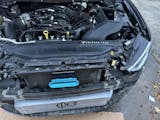Aerodynamics of a Ram Air Duct | Flow Separation
Flow Separation
Another mode of pressure drop and a critical design consideration for efficient internal flow characteristics is the phenomena of ‘flow separation.’ Flow separation, which is attributed to the S-shape of an internal duct, occurs on what we call the ‘suction side’ of the flow path (see below). The ‘suction side’ is a low-pressure zone of the flow path. Upon entering a turn, the flow begins the turn trajectory and bunches up against the ‘pressure side’ or back wall of the turn, in turn the low suction side sees this as a bias in pressure and causes flow reversal.
The corresponding low pressure zone which is due to the fluid radial momentum component through the turn, creates a region where flow will actually begin to reverse direction and create unwanted swirling of the fluid. This swirling is standing in place and removing useful energy from the flow path, it can be reduced by optimizing the flow path using CFD (computational fluid dynamics) simulations. These simulations are more than just hand calculations on convergence angles and tube length, they pinpoint regions of poor performance and allow engineers to optimize the design for the intended purpose.




